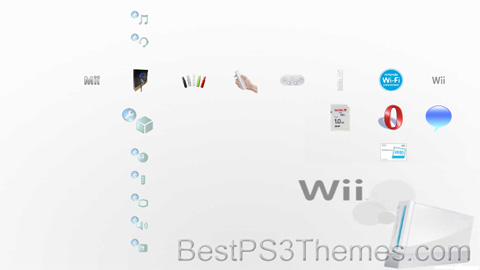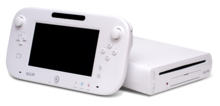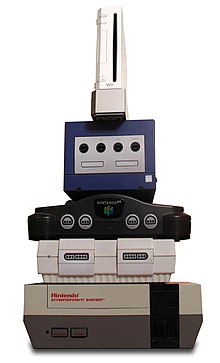Wii theme by WeirdKid
Download: Wii.p3t

(1 background)
 | |
 Original white Wii standing upright on its stand next to an original Wii Remote | |
| Also known as |
|
|---|---|
| Developer | Nintendo IRD |
| Manufacturer | Foxconn[1] |
| Type | Home video game console |
| Generation | Seventh |
| Release date | |
| Introductory price | |
| Discontinued | |
| Units shipped | 101.63 million (as of September 30, 2019[update]) (details) |
| Media | |
| Operating system | Wii system software |
| CPU | IBM PowerPC Broadway @ 729 MHz |
| Memory | 24 MB 1T-SRAM @ 324 MHz (2.7 GB/s) + 64 MB GDDR3 SDRAM |
| Storage | 512 MB NAND flash memory |
| Removable storage | |
| Display | Video output formats
|
| Graphics | ATI Hollywood @ 243 MHz |
| Controller input | |
| Connectivity |
|
| Online services | |
| Dimensions |
|
| Mass |
|
| Best-selling game |
|
| Backward compatibility | GameCube[a] |
| Predecessor | GameCube |
| Successor | Wii U |
| Website | wii |
The Wii[g] (/ˈwiː/, WEE) is a home video game console developed and marketed by Nintendo. It was released on November 19, 2006 in North America, and in December 2006 for most other regions of the world. It is Nintendo's fifth major home game console, following the GameCube and is a seventh-generation console alongside Microsoft's Xbox 360 and Sony's PlayStation 3.
In developing the Wii, Nintendo president Satoru Iwata directed the company to avoid competing with Microsoft and Sony on computational graphics and power and instead to target a broader demographic of players through novel gameplay. Game designers Shigeru Miyamoto and Genyo Takeda led the console's development under the codename Revolution. The primary controller for the Wii is the Wii Remote, a wireless controller with both motion sensing and traditional controls which can be used as a pointing device towards the television screen or for gesture recognition. The Wii was Nintendo's first home console to directly support Internet connectivity, supporting both online games and for digital distribution of games and media applications through the Wii Shop Channel. The Wii also supports wireless connectivity with the Nintendo DS handheld console for selected games. Initial Wii models included full backward compatibility support for GameCube games and most accessories. Later in its lifecycle, two lower-cost Wii models were produced: a revised model with the same design as the original Wii but removed the GameCube compatibility features and the Wii Mini, a compact, budget redesign of the Wii which further removed features including online connectivity and SD card storage.
Because of Nintendo's reduced focus on computational power, the Wii and its games were less expensive to produce than its competitors. The Wii was extremely popular at launch, causing the system to be in short supply in some markets. A bundled game, Wii Sports, was considered the killer app for the console; other flagship games included entries in the Super Mario, Legend of Zelda, Pokémon, and Metroid series. Within a year of launch, the Wii became the best-selling seventh-generation console, and by 2013, had surpassed over 100 million units sold. Total lifetime sales of the Wii had reached over 101 million units, making it Nintendo's best-selling home console until it was surpassed by the Nintendo Switch in 2021.[h] As of 2022, the Wii is the fifth-best-selling home console of all time.
The Wii repositioned Nintendo as a key player in the video game console marketplace. The introduction of motion-controlled games via the Wii Remote led both Microsoft and Sony to develop their own competing products—the Kinect and PlayStation Move, respectively. Nintendo found that, while the Wii had broadened the demographics that they wanted, the core gamer audience had shunned the Wii. The Wii's successor, the Wii U, sought to recapture the core gamer market with additional features atop the Wii. The Wii U was released in 2012, and Nintendo continued to sell both units through the following year. The Wii was formally discontinued in October 2013, though Nintendo continued to produce and market the Wii Mini through 2017, and offered a subset of the Wii's online services through 2019.
History[edit]
2001–2003: Development[edit]

Shortly after the release of the GameCube, Nintendo began conceptualizing their next console.[23] The company's game designer Shigeru Miyamoto said that, in the early stages, they decided they would not aim to compete on hardware power, and would instead prioritize new gameplay concepts.[24][25] The console was firstly named "GameCube Next" as a placeholder.[24] The price of the new console was originally envisioned to be as low as 100 euros but the NAND flash memory desired by Satoru Iwata would force that price to slightly more than the double.[24]
Miyamoto cited Dance Dance Revolution's unique game controllers as inspiration for developing new input devices.[26] Later in September 24, 2001, Nintendo began working with Gyration Inc., a firm that had developed several patents related to motion detection, to prototype future controllers using their licensed patents.[27]
Over the next two years, sales of the GameCube languished behind its competitors—Sony's PlayStation 2 and Microsoft's Xbox. Satoru Iwata, who had been promoted to Nintendo's president in May 2002 following Hiroshi Yamauchi's retirement,[28] recognized that Nintendo had not been keeping up with trends in the video game industry, such as adapting to online gaming. He also thought that video gaming had become too exclusive and wanted Nintendo to pursue gaming hardware and software that would appeal to all demographics.[29] Nintendo's market analysis found that their focus on novel hardware had created consoles that made it difficult for third-party developers to create games for, hampering their position.[30] One of the first major steps Iwata had made based on the company's research was directing the development of the Nintendo DS, a handheld incorporating dual screens including a touchscreen, to revitalize their handheld console line.[31]
In 2003, Iwata met with Miyamoto and Genyo Takeda to discuss their market research. Iwata instructed Takeda "to go off the tech roadmap" for this console, but said it had to be appealing to mothers.[32] Iwata wanted their next console to be capable of playing past Nintendo games, eliminating clutter in houses.[26] Takeda led the team building the console's hardware components, and Miyamoto spearheaded the development of a new type of controller, based on Gyration's motion-sensing technology.[27] Iwata had proposed that this new console use motion sensing to simplify the gaming interface, increasing appeal to all audiences.[33] An initial prototype was completed within six months.[34]
The Nintendo DS was said to have influenced the Wii's design, as the company found that the DS's novel two-screen interface had drawn in non-traditional players and wanted to replicate that on the new console.[26] Designer Ken'ichiro Ashida noted, "We had the DS on our minds as we worked on the Wii. We thought about copying the DS's touch-panel interface and even came up with a prototype." The idea was eventually rejected because of the notion that the two gaming systems would be identical. Miyamoto also stated, "if the DS had flopped, we might have taken the Wii back to the drawing board."[25]
2004–2005: Announcements[edit]
Prior to E3 2004, Iwata had referred to Nintendo's upcoming console offering as the GameCube Next (GCNext or GCN).[35] Iwata first unveiled some details of Nintendo's new home console at E3 2004 under the codename "Revolution", as Iwata believed the console would revolutionize the gaming industry.[29] BBC News' technology editor Alfred Hermida wrote that Nintendo's struggle to match Sony and Microsoft in the home console market made success crucial.[36]
The console, still named "Revolution", was formally presented to the public at E3 2005. The motion controller interface had not yet been completed and was omitted from the unveiling.[25] Iwata held the console above him with one hand to emphasize its size relative to its rivals. A smaller device meant it would draw on less power as to not overheat,[37] and thus appealed to parents who were willing to have an attractive, small, power-efficient device in the living room.[38] Iwata reportedly used a stack of three DVD cases as a size guide.[37] The prototype held by Iwata was black, but at release the following year, the console was only available in white. In their book on the console, two Loyola University Chicago professors suggested that Nintendo was inviting comparisons with Apple's first iPod line.[39]
Iwata later unveiled and demonstrated their current prototype of the Revolution controller at the Tokyo Game Show in September 2005. At this stage, the controller unit resembled the final Wii Remote device along with the separate Nunchuk attachment. Iwata demonstrated its motion sensing gameplay capabilities, and incorporated commentary from developers, such as Hideo Kojima and Yuji Horii, who had tested the controller and believed people would be drawn in by it.[40][41]

The console's name was formally announced as the Wii in April 2006, a month prior to E3 2006. Nintendo's spelling of "Wii" (with two lower-case "i" characters) was intended to represent both two people standing side by side, and the Wii Remote and its Nunchuk.[42] In the company's announcement, they stated: "Wii sounds like 'we', which emphasizes that the console is for everyone. Wii can easily be remembered by people around the world, no matter what language they speak. No confusion."[42]
The name resulted in criticism and mockery. Forbes expressed a fear that the console would be seen as juvenile.[43] BBC News reported the day after the name was announced that "a long list of puerile jokes, based on the name," had appeared on the Internet.[44] Some video game developers and members of the press stated that they preferred "Revolution" over "Wii".[45] Nintendo of America's Vice President of Corporate Affairs Perrin Kaplan defended the choice.[46] President of Nintendo of America Reggie Fils-Aimé justified the new name over Revolution by saying that they wanted something short, distinctive, and easily pronounceable for all cultures.[47]
The Wii was made available for a press demonstration at E3 2006. Planned launch titles were announced at a press conference alongside the unveiling. At the same conference, Nintendo confirmed its plans to release the console by the end of 2006.[48]
2006–2010: Launch[edit]

Nintendo announced the launch plans and prices for the Wii in September 2006. The console was first launched in the United States on November 19, 2006, for US$249.99.[7] Other regional release dates and prices included Japan on December 2 for ¥25,000,[8] followed by Australasia on December 7 for A$399.95,[10] and was later launched on December 8 in the United Kingdom for £179.99 and for the majority of Europe for €249.99.[9] Nintendo planned to have around 30 Wii games available by the end of 2006, and anticipated shipping over 4 million consoles before the end of the year.[49]
As part of its launch campaign, Nintendo promoted the Wii in North America through a series of television advertisements (directed by Academy Award winner Stephen Gaghan); its Internet ads used the slogans "Wii would like to play" and "Experience a new way to play". The ads began in November 2006 and had a budget of over $200 million for the year.[50] The ads targeted a wider demographic compared to ads for other consoles, inviting parents and grandparents to play on the Wii.[51] Nintendo hoped that its console would appeal to a wider demographic than that of others in the seventh generation.[52] In December 2006, Satoru Iwata said that Nintendo did not think of themselves as "fighting Sony", but were focused on how they could expand the gaming demographic.[53]
It took several years for the Wii to launch in other regions. It was released in South Korea on April 26, 2008,[54] Taiwan on July 12, 2008,[55] and Hong Kong on December 12, 2009.[56] Nintendo had planned work with its localization partner iQue to release the Wii in China in 2008, but failed to meet the requirements to circumvent the ban on foreign-made consoles the Chinese government had put in place.[57][58]
2011–2017: Successor and discontinuation[edit]

Nintendo announced the successor to the Wii, the Wii U, at E3 2011.[59][60] Nintendo had recognized that the Wii had generally been shunned by the core gaming audience as it was perceived more as a casual gaming experience. The Wii U was aimed to draw the core audience back in with more advanced features atop the basic Wii technology.[61][62] The Wii U features the Wii U GamePad, a controller with an embedded touchscreen and output 1080p high-definition graphics that serves as a secondary screen alongside the television. The Wii U is fully backward-compatible with Wii games and peripherals for the Wii, including the Wii Remote, Nunchuk controller and Wii Balance Board, and select Wii U games including support for these devices.[63] The Wii U was first released on November 18, 2012 in North America; November 30, 2012 in Europe and Australia, and December 8, 2012 in Japan.[64]
Nintendo continued to sell the revised Wii model and the Wii Mini alongside the Wii U during the Wii U's first release year. During 2013, Nintendo began to sunset certain Wii online functions as they pushed consumers towards the Wii U as a replacement system or towards the offline Wii Mini, though the Wii Shop Channel remained available.[65] Nintendo discontinued production of the Wii in October 2013 after selling over 100 million units worldwide,[66] though the company continued to produce the Wii Mini unit primarily for the North American market.[67] The WiiConnect24 service and several channels based on that service were shuttered in June 2013.[19] Support for online multiplayer games via the Nintendo Wi-Fi Connection were discontinued in May 2014,[18] while the Wii Shop was closed in January 2019, effectively ending all online services for the console.[20][68] The Wii Mini continued to be manufactured and sold until 2017.[69]
Despite the Wii's discontinuation, some developers continued to produce Wii games well beyond 2013. Ubisoft released Just Dance games for the Wii up to Just Dance 2020 (2019).[70] Vblank Entertainment's Shakedown: Hawaii along with Retro City Rampage DX are the most recent Wii games, which were released on July 9, 2020 (more than 13 years after the Wii's launch).[71][72] On January 27, 2020, Nintendo announced that it will no longer repair any faulty Wii consoles in Japan starting on February 6 due to a scarcity of spare parts.[i]
Hardware[edit]
Console[edit]

In building the Wii, Nintendo did not aim to outpace the performance of their competitors. Unlike the company's previous consoles, they built the Wii from commercial off-the-shelf hardware rather than seek out customized components. This helped to reduce the cost of the Wii system to consumers.[74] Miyamoto said "Originally, I wanted a machine that would cost $100. My idea was to spend nothing on the console technology so all the money could be spent on improving the interface and software."[75]
The console's central processing unit is a 32-bit IBM PowerPC-based processor named Broadway, with a clock frequency of 729 MHz.[76][77] The reduced size of Broadway—based on a 90 nm process compared to the
